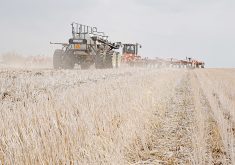Grain Growers of Canada worries there will be little opportunity to extend it now that Parliament has been prorogued
Glacier FarmMedia – Canada’s extended interswitching pilot is running out of track, and Grain Growers of Canada worries that letting the program expire will create significant disruption for the smooth flow of grain.
The program, which opens up rival rail routes for shippers under certain conditions, has been in place since 2023 and is set to expire in March.
The timeline is further compressed by the prorogation of Parliament in early January. Parliament is out until March 24.
Read Also

Saskatchewan firm aims to fix soil with compost pellets
In his business, Humaterra, Leon Pratchler is helping farmers maximize yields in the weakest areas of their fields through the use of a compost pellet.
“There is effectively no path forward for the program’s renewal or permanency before its expiry, leaving grain farmers and the grain sector once again exposed to the uncompetitive forces of rail monopolies,” the organization said in a Jan. 16 statement.
Interswitching applies when a shipper has access to a single carrier but is located within a specific radius of other lines.
Interswitching regulations have been in place since 1904, but they became critical in 2013 when an exceptional harvest in Western Canada overwhelmed the rail system, delaying grain shipments to export terminals.
The old radius of 30 kilometres was extended to 160 in 2014 to ease those logistical hurdles.
In a 2016 review, then-MP David Emerson, who conducted the reassessment, advised the federal government to roll back the expanded radius. There had been little use of the expanded limits, he said. The rule should go back to 30 km, which it did in 2017.
At the same time, though, Emerson expressed concern over rail monopolies and how they could harm grain shippers. His review also suggested broadening interswitching options.
Part of the response was Long-Haul Interswitching (LHI), which allowed shippers to access competing rail carriers within 1,200 km, assuming they made arrangements for the transfer with their local carrier, or if negotiations failed, appealed to the Canadian Transportation Agency.
The latest round of interswitching drama kicked off after the 2021 drought, when railways cut grain cars, thinking harvest would be small. After deliveries fell short, interswitching blazed back into the limelight.
In 2023, a new pilot re-extended the radius to 160 km for 18 months.
Advocates for extended interswitching argue that the program provides essential competition within Canada’s rail duopoly, reducing shipping costs, improving service reliability and enhancing supply chain predictability.
“Its expiry will be a step backward for the sector, once again leaving the agriculture sector with no true competitive rail service options,” the GGC said.
It also argued that provisions to extend or make the program permanent could have been added to the last fall economic statement, calling the pilot a “no-cost initiative supporting the agriculture sector and broader economy.”
















